BMW Performance Center
Spartanburg, SC
Two-Day School Experience
May 15 & 16, 2006
Day 1
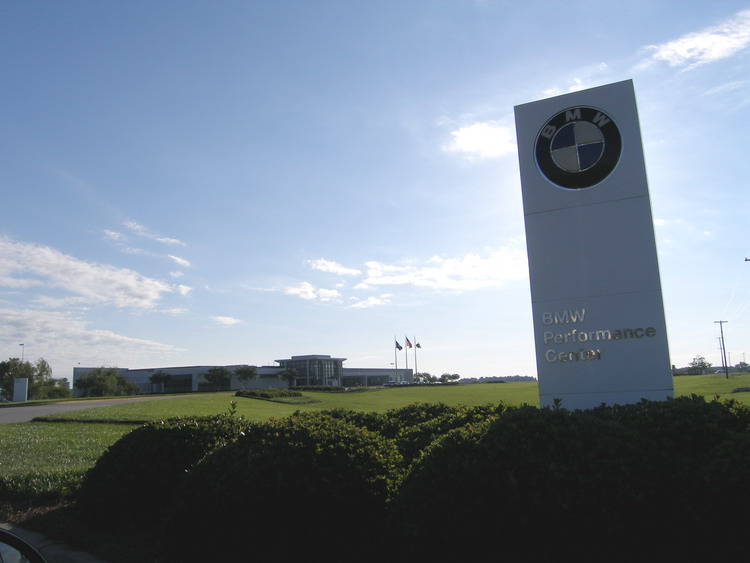
Introduction
Shortly after I hit my second deer one rainy night in the 328 I contemplated whether I could have done anything differently to avoid the collision. I performed a classic panic stop and managed to get the car down to less than 5MPH before I hit the animal, but after my heart rate returned to normal I secretly wondered if things would have turned out better if I'd had the courage to make an aggressive lane change at the last second. Of course, I knew the answer. I was simply uncomfortable with this vehicle at its limits because I lacked the courage to put the vehicle at risk to test those limits in the first place.
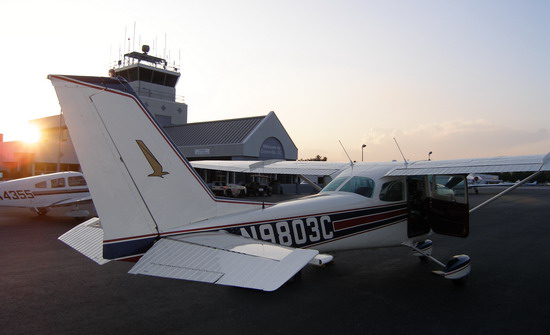 As a pilot I'm taught to analyze unexpected or
abnormal situations and develop a course of action to handle them better in
the future, so it really didn't come as a surprise when I concluded I might
benefit from some formal training that would teach me how to operate a vehicle
at or beyond its limits. I had heard good things about the classes at the BMW
Performance Center in Spartanburg, South Carolina, so after reading about the
courses on the BMW website, I decided to schedule the Two-Day school.
As a pilot I'm taught to analyze unexpected or
abnormal situations and develop a course of action to handle them better in
the future, so it really didn't come as a surprise when I concluded I might
benefit from some formal training that would teach me how to operate a vehicle
at or beyond its limits. I had heard good things about the classes at the BMW
Performance Center in Spartanburg, South Carolina, so after reading about the
courses on the BMW website, I decided to schedule the Two-Day school.
When I mentioned my plans to a colleague and fellow BMW enthusiast, Chip, he related an experience he had with his 528 on a slick off ramp. In virtually no time he and I had worked out some of the logistics and agreed to meet in Spartanburg on May 15th and 16th, 2006.
Flying Down
The plan was for me to fly down in the 172 simply because I had that option available, while Chip would fly the executive mailing tube from Philadelphia down to Charlotte and drive the hour+ to the hotel. Easy enough. All I needed now was good weather.
I had planned to leave late morning Sunday so I got up pretty late on Saturday, thinking I'd take it easy, run some errands, and prepare for the trip over the course of several hours. And then just after 10AM I saw the weather forecasts for Sunday. Panic set in. 20MPH sustained winds with 40MPH gusts? Heavy Rain? Severe thunderstorms? Turbulence? A peek at the forecasts for the remainder of the afternoon convinced me I had to get the hell out of there right now. In a flurry of activity I called the hotel to ask if there were sufficient rooms available to arrive a day early, completed my flight planning, packed my bags, headed to the airport, topped off the tanks, and launched in record time at 1PM.
Due to slightly unfavorable winds, it took me 3 stops and about 5.5 hours of flight time to get to the Greenville Downtown airport. I had called the Fixed Based Operator (FBO) on the field and let them know when I'd be there. They had everything in order when I arrived, including a van at the ready to take me to the hotel -- the Hilton Greenville -- at which I received a special "BMW Performance Center" rate.
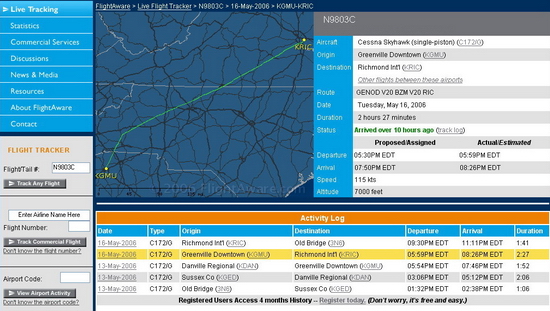 By the time
I got settled in my room at the hotel it was close to 9PM. While there were
a few restaurants in the area, including an Outback right across the street,
I was too tired to get cleaned up to go out so I took a chance and called Room
Service. In retrospect I don't think I could have found a better deal on the
outside. Aside from their mandate to cook all meats well done, the meal was
prepared to my liking and very tasty. I enjoyed the salad with balsamic vinaigrette
in particular.
By the time
I got settled in my room at the hotel it was close to 9PM. While there were
a few restaurants in the area, including an Outback right across the street,
I was too tired to get cleaned up to go out so I took a chance and called Room
Service. In retrospect I don't think I could have found a better deal on the
outside. Aside from their mandate to cook all meats well done, the meal was
prepared to my liking and very tasty. I enjoyed the salad with balsamic vinaigrette
in particular.
I awoke Sunday morning to less than ideal weather, confident that I'd made the right decision to arrive early. Around 2PM the skies cleared as a front moved farther to the east than originally forecast. The winds were still high, but at least the severe thunderstorm and tornado warnings being posted were several hundred miles to the east. This was an early indication of favorable weather to come to the Greenville / Spartanburg area. I spent the day surfing the net over the hotel's wireless internet connection. Aside from some performance issues with their network connection I was able to check up on weather, read my favorite BMW sites, and give myself the day off I gave up yesterday.
Chip arrived later that evening and we headed across the street to the Outback for a good filling meal and what had to be the largest single scoop of ice cream I've ever seen.
Day 1: May 15, 2006
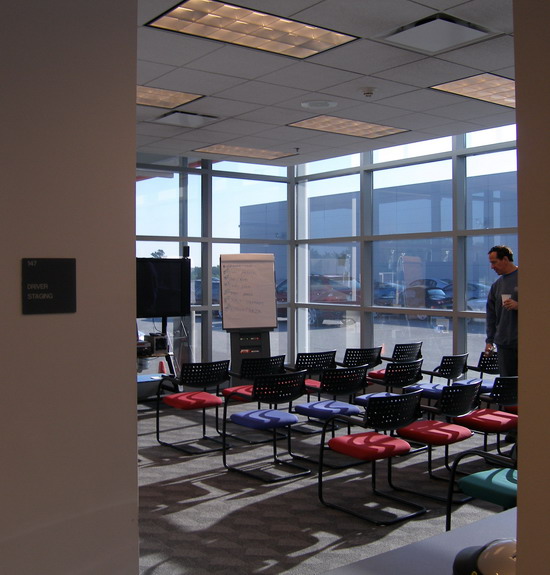 On Day 1,
Chip and I arranged to meet in the hotel lobby at 7:30 so we could run by the
local Starbucks to pick up some muffins and coffee. We arrived at the performance
center around 8AM only to find out that the cafeteria was open at that hour
and serving eggs to order and other comfort foods.
On Day 1,
Chip and I arranged to meet in the hotel lobby at 7:30 so we could run by the
local Starbucks to pick up some muffins and coffee. We arrived at the performance
center around 8AM only to find out that the cafeteria was open at that hour
and serving eggs to order and other comfort foods.
Other class participants began to gather in the cafeteria as well, and before long one of the instructors introduced himself and started passing out the waiver we had to sign. As far as wavers go this was pretty painless. Skydiving waivers can be 10+ pages long and require initials alongside every paragraph. The BMW waiver, on the other hand, basically said that we agree to indemnify BMW and all participants from any and all legal action. There were maybe 8 paragraphs to read, and knowing what fun we were about to have, I willingly signed it.
We were then led to the driver staging room near the rear of the facility. This classroom was like no other I had in college -- it had a great view of the MILLIONS of dollars worth of high performance sports cars at our disposal. I gawked at the lineup of competition package M3's. Damn, there's an M5, and another! And what is this? A brand-new Z4M roadster with the M3 engine? The new $80K V8 powered 6 series? Wow. It didn't take long for a shit-eating grin to appear on my face. I couldn't believe I was here. It was as close to Mecca for BMW drivers as it gets.
By 8:30, our class of 16 sat down for more staff introductions. Our primary instructors would be Matt and Jim, both accomplished race car drivers and long-time Performance Center employees. Their friendly smiles and lighthearted nature put everyone at ease as we went around the room briefly describing what brought us to the Performance Center. I related my deer hits and my realization that the capabilities of my new 330ci exceeded those of its driver, while Chip mentioned his 360 on the off ramp. One father and son team were buying an M3 as a graduation gift, one mother received the course as a gift from her kids (hmmm...I wonder what they were trying to say???), and one guy mentioned he brought his fiance there because he saw her persistent tailgating of other vehicles as a problem waiting to happen -- she needed to be taught a lesson about the relationship between speed and braking distance. We came from diverse backgrounds but had a common goal -- to become better, safer drivers of our BMWs.
The instructors then pointed out that the purpose of the two day course was to help us learn more about vehicle dynamics and handling in controlled conditions to and beyond the limits of the vehicle so that we could use our new-found skills to prepare us for the real world. Matt went through a few presentation slides using the classroom's state of the art widescreen LCD monitor, the first of which outlined the high-level goals for the class: Safety, Fun, Excitement, Education.
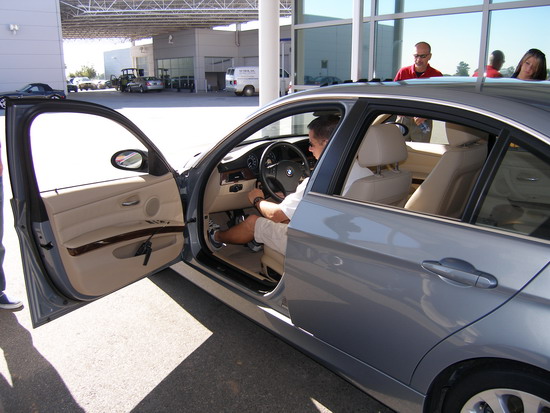 The plan
was to drive eight new identically configured and colored E90 sedans. We'd
go out in one group of eight or two groups of four cars (depending on the exercise)
and two drivers to a car, switching as necessary. Naturally, Chip and I paired
up and we met out at the first car in the lineup with the remainder of the
class for a brief instructional session in which Jim told us how to provision
the seats, adjustable steering wheel, and mirrors for optimum comfort and safety.
He emphasized that we were to hold the wheel at 9 and 3 (NOT 10 and 2) because
that would give us positive control of the vehicle and optimum leverage.
The plan
was to drive eight new identically configured and colored E90 sedans. We'd
go out in one group of eight or two groups of four cars (depending on the exercise)
and two drivers to a car, switching as necessary. Naturally, Chip and I paired
up and we met out at the first car in the lineup with the remainder of the
class for a brief instructional session in which Jim told us how to provision
the seats, adjustable steering wheel, and mirrors for optimum comfort and safety.
He emphasized that we were to hold the wheel at 9 and 3 (NOT 10 and 2) because
that would give us positive control of the vehicle and optimum leverage.
One of his first questions to the group was "How many of you set up your side mirrors such that you can barely see the sides of the vehicle?" About 70% of the class, myself included, raised their hands. He quickly retorted "well, that's wrong!", and thoroughly explained how to configure the mirrors so we covered all areas around the vehicle properly. And to think, I've been doing it wrong for 20 years. It's common sense when you think about it, but I'd never been taught that. By the end of the briefing I figured I'd already gotten my money's worth, but I figured I'd stick around for the remainder of the course just for fun. :-)
Braking Exercise
The first exercise called for us to park our cars on a nearby section of the course while we all walked over to a section of the facility setup to provide a braking exercise. Cones were placed every 10 feet from a starting line. The first 70 feet or so the cones were straight, but assumed a slight curve after that.
Matt told the group that he would make a first pass at 20 MPH and brake at the first set of cones. We were to stand to the side of the asphalt nearest the the distance we thought it would take him to stop. I stood at around the 30 foot mark. He stopped in a mere 10 feet with ABS clearly active.
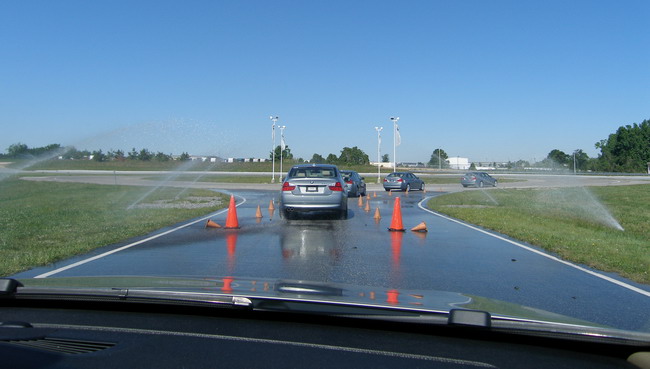 The next
run he doubled the speed to 40 MPH. I and many others stood at the 35 foot
mark. He stopped in just over 40 feet and calmly told us, in effect, that we
were all road pizza. Thus the first rule of thumb learned -- double the speed,
quadruple the stopping distance. For this reason, he emphasized, it's dangerous
to tailgate vehicles, particularly when driving at highway speeds.
The next
run he doubled the speed to 40 MPH. I and many others stood at the 35 foot
mark. He stopped in just over 40 feet and calmly told us, in effect, that we
were all road pizza. Thus the first rule of thumb learned -- double the speed,
quadruple the stopping distance. For this reason, he emphasized, it's dangerous
to tailgate vehicles, particularly when driving at highway speeds.
At that point we got back in our cars and ran through the braking exercise starting at 40 MPH and progressing to 55 MPH. At the higher speed we knew we'd reach the end of the straight portion of the course and enter the curved portion, so the exercise took on an added instructional lesson -- how to brake the car aggressively and maintain steering around the curve. We quickly learned (as I had during my deer encounter) that the proper way to brake a car with ABS is to put the pedal through the floor -- literally try to break the pedal off its mounts -- and steer where you want to go. The car will do the rest.
Simple Slalom
The next exercise of the day was a simple slow-speed slalom course. The Matt led us in an X5 through the course at around 25 MPH, and then pulled over and got out to watch each of us go through the course at progressively higher speeds. The goal here was to learn basic control technique and learn how to brace ourselves in the vehicle.
The lessons learned involved our use of the dead pedal to stabilize ourselves as the lateral G-forces pushed us around, proper 9 and 3 hand positions on the wheel to maintain positive control, and to judge distance and handling such that we aggressively turned the car around the obstacles (cones) without hitting them.
Single Lane Change
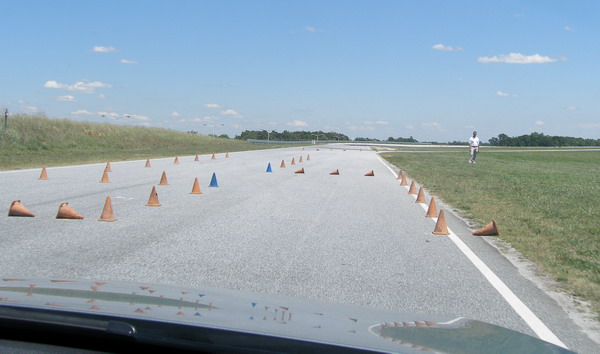 The
single lane change exercise was designed to simulate a real-world scenario
in which an obstacle suddenly appears in the road and the driver has to change
lanes to avoid a collision.
The
single lane change exercise was designed to simulate a real-world scenario
in which an obstacle suddenly appears in the road and the driver has to change
lanes to avoid a collision.
Cones were configured in such a way that we would approach them in the right lane and a execute a lane change to the left. We started at 25 MPH and slowly worked up to 45 MPH. Brakes were not to be used until the car was established in the opposite lane, but when we did use them we were instructed to apply maximum braking to bring the car to a full stop in a straight line in minimum distance -- in other words, we were to use the knowledge gained in the braking exercise and execute a panic stop.
This sounds easy, but was actually quite challenging -- particularly at 45 MPH -- because of the timing necessary. The opening provided to change lanes was only 5 feet longer than the vehicle. Start the turn too early or late and you'll clip cones. The trick was learning how long the vehicle required to respond to the steering input. As these were not sport-package cars, the vehicles tended to ponder aggressive turns as the body roll preceded the actual turn.
The group did quite well as a whole. There was one standout in this exercise - the boyfriend of the "tailgater", but this was to be expected since he had prior performance driving experience. Rest assured, however, that he didn't make everyone look bad in every exercise. Like everyone else, he was better at some things than others. It was great having a more experienced driver in the group because without realizing it he spurred a lot of friendly competition between classmates. We all strived to drive as well as we could, and that's a good thing. Every time someone would restage at the conclusion of their run, passing by the other cars in the process, we'd see big smiles on their faces and the occasional "touchdown" hand signals. :-)
Lunch
After approximately 3 solid hours of driving (with short restroom breaks between exercises) lunch time arrived. Matt and Jim told the class to meet them back in the staging room in about an hour and we found our way to the cafeteria again, this time with the promise of a free lunch. The food was good and there was a pretty good selection. I chose one of the prepared chicken wraps to keep things simple, but I noticed the chefs preparing hot sandwiches and the like. There were fresh salads and a good selection of dressings available so I grabbed one of those as well.
After we finished eating, I went back to the staging room to get my laptop because I'd heard that BMW provided public internet access in the cafeteria area. Sure enough I picked up their G access point and got an IP, but no routing to the net. Not sure why. I was about to start troubleshooting it and bring it up to someone when I stopped myself. I was here to drive and relax, not troubleshoot networks like I do every day. Priorities, right? If I could make any suggestion to BMW it would be to 1) fix the problem and 2) publish necessary procedures or credentials required for access so we can use the few minutes during lunch to check email and (in my case) weather.
Skidpad
If I had to put a finger on one area of vehicle handling with which I was most uncomfortable prior to arriving at the Performance Center it would have to be oversteer -- a term used to describe a skidding condition when the rear begins to accelerate toward the outside of the turn. What makes oversteer difficult for most people is the fact that it's a divergent condition, meaning it gets worse with time given the same control inputs, and that steering inputs required to counter oversteer are less than intuitive.
Fortunately, the Performance Center has a polished concrete skidpad that gives class members the opportunity to practice the skills necessary to recognize a developing oversteer condition and issue the correct steering inputs to counter the condition. Of course, since the natural ability of BMW's Dynamic Stability Control is to prevent unstable conditions such as oversteer, for the first part of the exercise we were instructed to turn DSC off. We again took turns in the driver's seat of the E90's, but this was the first exercise in which Matt or Jim sat in the car with us to give the driver real-time feedback on their performance. Chip was first to get on the skidpad and I got to watch from the back seat.
We accelerated and tried to keep the front left wheel on or near the center of the pad. Jim then said "gas gas gas" and Chip complied by mashing the throttle. The loss of traction from the spinning rear wheels caused an oversteer condition to develop. Chip was instructed to try to counter steer to stabilize the car in the oversteer condition and recover. The tendency in this situation is to look where the car is skidding, but the instructors reminded us to look where we wanted the car to go. It was harder to do than one might think. Both of us wound up doing our share of 180's. It was educational, as well as a ton of fun, and I feel that most of the class really took to it.
In the second part of the exercise we were instructed to flip DSC back on and push the throttle to the floor to serve as a test of what DSC does to keep the car in check. I laughed out loud as I mashed the throttle to the floor and drive around the inside of the pad effortlessly, in full control, in spite of the ridiculous throttle position that would have otherwise sent me careening out of control. I took away the impression that DSC works, and works well.
The hardest part of the skidpad exercise for me was recognizing the oversteer condition quickly enough to add the initially large steering input to counter the acceleration and then use smaller inputs to maintain the drifting condition, but I managed to maintain the drift for almost 1/2 a circle before Jim induced more oversteer by momentarily pulling the emergency brake. Aggressive input followed by smaller inputs. I recovered cleanly enough, and Jim soon asked me to exit the course and restage. Although this exercise took the most amount of time because we could only do two cars on the pad at once (and trust me -- you wouldn't want more than that), it was over all too soon.
Handling Course
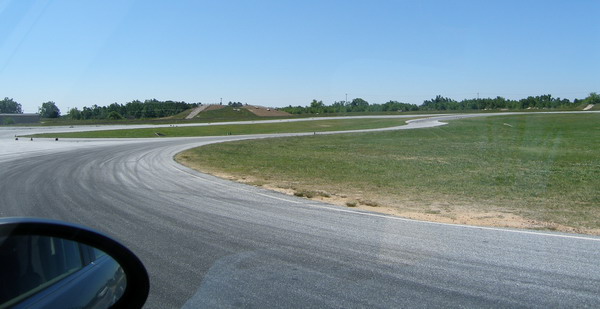 By far
the most fun exercise on Day 1 (for me, anyway) was the handling course. This
exercise was designed to combine the skills we'd learned up to that point and
add some high-speed vehicle dynamics. The words "understeer" and "oversteer" were
discussed and sampled earlier in the day and this is where we put the concepts
to the test.
By far
the most fun exercise on Day 1 (for me, anyway) was the handling course. This
exercise was designed to combine the skills we'd learned up to that point and
add some high-speed vehicle dynamics. The words "understeer" and "oversteer" were
discussed and sampled earlier in the day and this is where we put the concepts
to the test.
All BMWs are configured from the factory to understeer. The reason, according to the instructors, is that BMW believes the average driver will be able to recover from an understeer condition more easily than an oversteer. And I'd have to agree. Jim added that in any case the fastest cars on the track will always be those that are configured to understeer slightly so a tendency to understeer isn't all that bad.
While this exercise wasn't timed, we were encouraged to drive the cars hard and fast, but under control. Matt and Jim walked to the apexes of the two challenging turns in the course and using the radio coached us as we drove the line around the curves. Most of us turned in too early and encountered severe understeer as we tried to crank it around the apex, but with feedback from both Matt and Jim (and, truth be told, a few strategically placed cones) we eventually saw the light and went wide in the early portion of the turn, braking heavily to get the car down to a speed in which it would handle the turn, drive it through the apex on the inside -- practically running over Jim's toes -- and then accelerate out of the turn.
At one point Jim explained the "string theory". Imagine there's a string connected between the throttle and the bottom of the steering wheel. If the wheel is straight, we're able to push the pedal to the floor to make the car go as fast as it will go. But as we add steering input, the string pulls up on the pedal and limits our maximum throttle input. With that new-found knowledge, we honed our vehicle handling skills.
On Chip's turn around the course, I managed to get some great video [YouTube]:
Once we'd had some experience on the course, Matt and Jim told us we'd go around the course once again, but this time we were timed. Oddly enough, "Ms. Tailgater" pulled the best time as I recall. Her lead foot definitely came in handy on this exercise!
End of Day One
Even though we'd been driving all day and I was definitely feeling tired, the end of Day One came all too quickly. After everyone brought their cars back to the terminal we gathered in the staging room to say goodbye to the few folks who were here only for the One-Day school and to outline the plan for Day 2. We all agreed to meet back in the staging room at 8:30AM the following day and at that point Matt gave everyone a BMW Performance Center hat while those departing also received their completion certificates.
As the class filed out of the staging room, Chip and I pulled Matt and Jim aside to ask them for their recommendations for a good place to eat. They recommended a place in the newly revitalized downtown Greenville -- just a few miles west of our hotel -- so we thanked them for their help and left for the hotel.
Later that evening we drove into downtown Greenville. Maybe it was all the beautiful young southern girls I saw walking down the street or just the cobblestone walkways and tree-lined streets (likely both), but I found it to be one of the nicest downtown areas I've seen. It reminded me of a cross between cozy feel of downtown Princeton combined with the history of Boston. It was clear that a lot of money had gone into revitalizing the area, and while we didn't get to see much more than main street with its many shops, restaurants, and brew pubs, I knew I wanted to come back to do a bit more exploring next time I was in the area. I'd definitely recommend a trip to downtown Greenville for friends, couples, or family when you're down at the Performance Center, and if you choose to stay at the Hilton Greenville, you'll be that much closer to the city.
We never did find the restaurant Matt recommended but we ate in a great local Mexican joint and later found our way to a brew pub for a full-bodied lager. As I began sipping my brew, I felt compelled to break out an old joke from the television show Cheers -- in my best "Norm" voice I told Chip "better stop me at one....uh, better make that 1:30".



